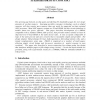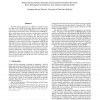802 search results - page 5 / 161 » A comparative study of power efficient SRAM designs |
ICCAD
2007
IEEE
14 years 4 months ago
2007
IEEE
— The need to perform power analysis in the early stages of the design process has become critical as power has become a major design constraint. Embedded and highperformance mic...
ARVLSI
1997
IEEE
13 years 12 months ago
1997
IEEE
The growing gap between on-chip gates and off-chip I/O bandwidth argues for ever larger amounts of on-chip memory. Emerging portable consumer technology, such as digital cameras, ...
ISCA
1997
IEEE
13 years 11 months ago
1997
IEEE
Portable systems demand energy efficiency in order to maximize battery life. IRAM architectures, which combine DRAM and a processor on the same chip in a DRAM process, are more en...
ICCD
2008
IEEE
14 years 2 months ago
2008
IEEE
— SRAMs typically represent half of the area and more than half of the transistors on a chip today. Variability increases as feature size decreases, and the impact of variability...
ISQED
2010
IEEE
13 years 6 months ago
2010
IEEE
Low power, minimum transistor count and fast access static random access memory (SRAM) is essential for embedded multimedia and communication applications realized using system on...


